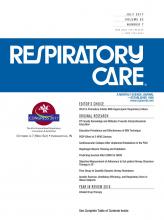Abstract
BACKGROUND: Dynamic airway resistance from obstructive disease causes a concavity in the mid-expiratory portion of the spirometric flow-volume loop. We developed a simple model to measure the exponential decay in air flow during forced exhalation to quantify the extent of dynamic airway obstruction and facilitate the detection of obstructive airway diseases clinically.
METHODS: We calculated flow decay as the slope of volume versus ln(1/flow) in mid-exhalation. We derived the normal range in a derivation group of healthy volunteers in whom spirometry had been performed repeatedly. We validated the derived upper limit of normal (mean + 2 × SD) by using it to distinguish a separate group of healthy subjects (n = 25) from subjects with independently diagnosed reversible airway obstruction (n = 31) and subjects with obstruction, hyperinflation, and air trapping (n = 62).
RESULTS: In the derivation group (n = 7), the mean ± SD flow decay was 0.588 ± 0.107 L−1 (upper limit of normal = 0.802 L−1). Flow decay in 23 of 25 healthy subjects in the validation group was below the upper limit of normal. In contrast, it was above the upper limit of normal in 29 of 31 subjects with reversible airway obstruction (sensitivity 94%, 95% CI 79–99%; specificity 92%, 95% CI 74–99%) and in 59 of 62 of subjects with obstruction, hyperinflation, and air trapping (sensitivity 92%, 95% CI 74–99%; specificity 95%, 95% CI 86–99%).
CONCLUSIONS: Flow decay distinguished subjects with obstructive lung defects from healthy subjects. It is a straightforward representation of spirometry data that provides a reproducible index to quantify dynamic airway obstruction.
Footnotes
- Correspondence: Timothy A Morris MD, University of California, San Diego Medical Center, 200 West Arbor Drive, San Diego, CA 92103-8378. E-mail: t1morris{at}ucsd.edu.
Dr Oh presented a version of this paper at the 2013 International Conference of the American Thoracic Society, held May 19–24, 2013, in Philadelphia, Pennsylvania.
This work was supported, in part, by NHLBI, National Institutes of Health, Grant T32 HL098062. The authors have disclosed no conflicts of interest.
- Copyright © 2017 by Daedalus Enterprises











